I spend a lot of time teaching students skills I hope will lead to good jobs in a profession they love. I had the joy of such a life, and I want to pass that joy around.
So, how do we learn anything in this life? To me, it has always been by "pushing the edge".
Racing Motor Vehicles
It seems every teen-aged male, and a lot of females as well, like to go fast in automobiles at some point in their lives. How do you learn to do that?
Well, right after you pass that drivers test is probably not a good time to start trying to go fast (especially if the driving examiner is watching you pull away). Instead, a good way might be to take a car to a safe place, like a race track, and get a good instructor, like one trained in racing, to show you how it is done in a safe way.
You could do that, but the best way is to take your time and get good at it as you go!
You will start off slow, and build up a set of skills over some finite amount of time. I know this is counter to everything the current generation seems to believe. They want to do something instantly, without investing any time to learn how to do things properly, safely, and skillfully. And many of them "just do not have time!" (I think I should mention the word FaceBook at this point, but I will not!).
I did a bit of just what I am talking about when I first learned how to drive, but I used a motorcycle as my learning tool, since I got my first car late, several years after I started riding motorcycles.
I got my first motorcycle while working at McDonnell Aircraft in St. Louis as a freshman at Virginia Tech. That was my ride to work every morning, and it was just a simple Honda 90cc bike that looked like this:
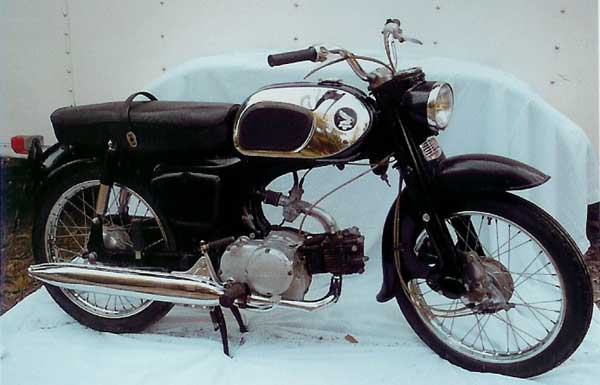
I remember that this thing cost me $400, a fair amount of money back in 1965. I put a ton of miles on this bike, storing it in my grandmother's basement when I went back to school. It was my ride to work for over three years.
Riding exposed to the elements is both fun, and not so fun. One of the first things that amazed me was how much the temperature changed as you drive along. Even in Summer, when it was warm enough to ride with short sleeves (dumb if you fall off, by the way), as you drop down into a valley, the temperature can change dramatically. I later learned in my studies at Tech, that warm air rises, and cold air sinks, and guess where it sinks to? Those valleys is where, they could be COLD!
I also learned not to think that everything that looks like fog really is!
One night, I was riding along the Missouri river after a hot date with Dody (that is another story), I thought I saw a fog bank in the headlight up the road. Shoot, I can drive through fog as long as I can see the edge of the road, so I did not slow down at all. Bad mistake. I hit the "fog" at around 50 miles per hour only to find out it was a swarm of locusts. Bang, Squash, Splat, Ugh! I was pelted by those things for almost a full minute as I struggled to escape that swarm, it was huge!
I was so covered in bug-guts, that I immediately started looking for a car wash and spent over an hour trying to get the dead bugs off of me and my lovely little Honda. It was over a year before I stopped finding chunks of bug leg or something wedged in some crack in the bike.
After I graduated from Virginia Tech, I started Graduate School, and upgraded my motorcycle to a Honda 175.
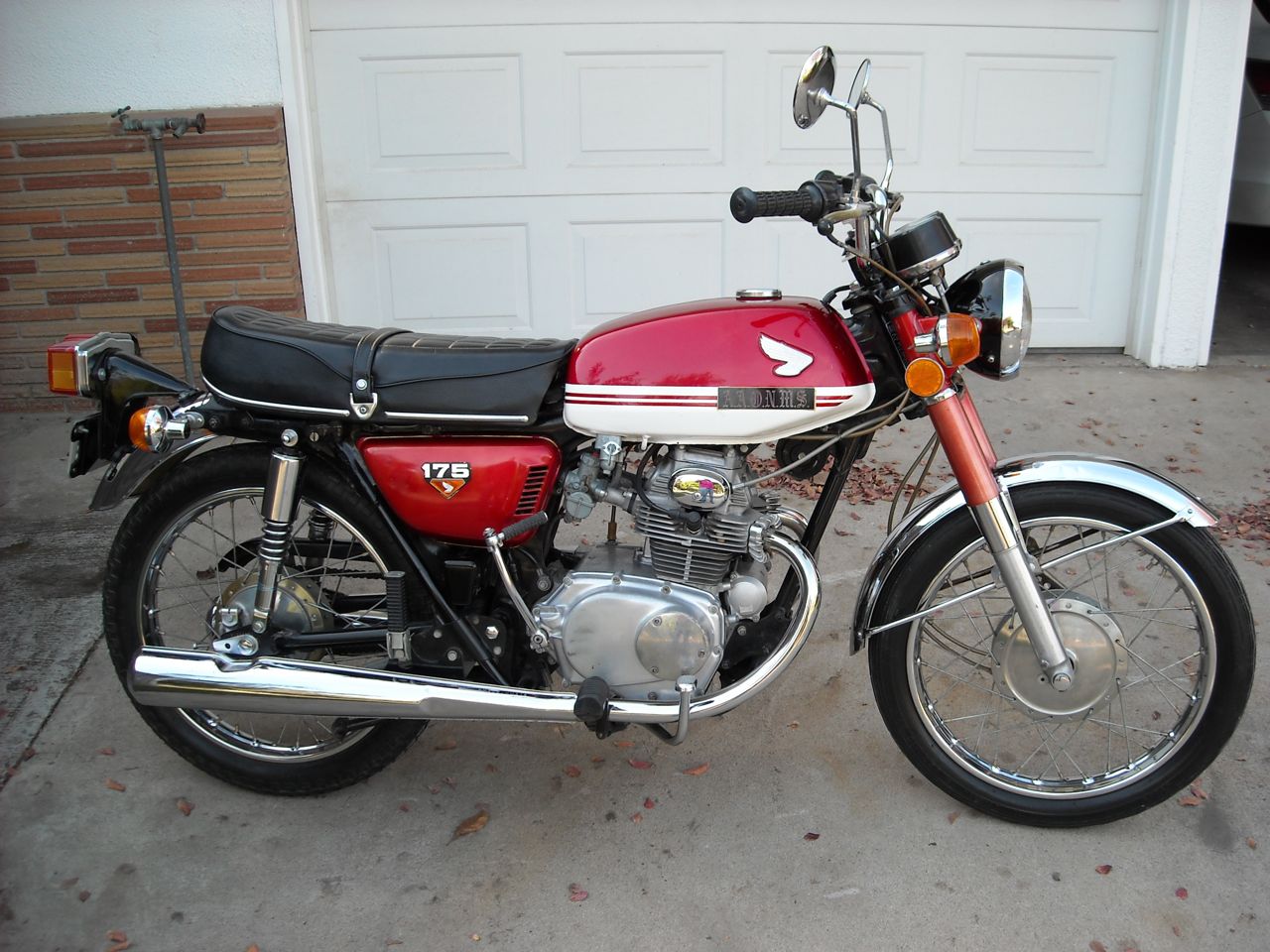
This was a much nicer bike, and it could sail down the highway with traffic much better than my old 90. I was able to go faster just as a result, so I guess I was learning how to be comfortable moving along in the wind!
I lived in a trailer park, in a trailer I bought for $4000. I had to live off campus, and someone told me it was much better to own a place to live that you could sell later, than to pay rent for an apartment, and get nothing back in the end. So the trailer was my first investment, and I ended up selling it for $3000 almost five years later. Not bad!
The motorcycle, and my first car, a 1964 Chevrolet Impala SS (nice!) was now my primary ride, but I still rode the motorcycle, except in the worst of winter.
Unfortunately (or fortunately, depending on your point of view), I had a neighbor, John Donley, another Tech student, who was trying to start a motorcycle business. He and I started riding out in the mountains of Virginia on our street bikes. Eventually we ended up in McCoy Virginia where we found an abandoned coal mine, with a bunch of pits where coal had been removed, a few mine shafts, and trails all up and down the area that led to other operations. A great place to ride motorcycles, but definitely not a paved road to be seen.
As it turned out the place was full of guys riding motorcycles of all kinds here, and we joined in. But, the guys were real-life coal miners from West Virginia, and these guys were just plain nuts! They thought nothing about slugging down a beer (or more), jumping on their bikes, and blasting off into and out of those "pits" leaping into the air as they did.
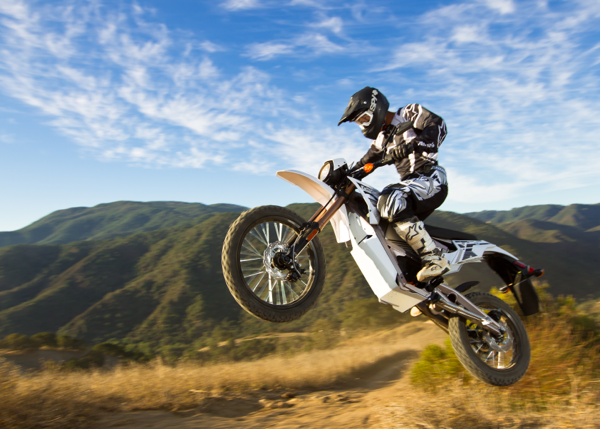
This actually is a picture of a new electric motorcycle that works like my old dirt bikes, (but I am getting ahead of myself!)
John and I joined in, but our street bikes were not up to this kind of riding. We were going fast, and leaping into the air as well. Great fun, but it has its problems.
On one leap I made coming out of a pit, I was standing on the foot-pegs when the bike hit the ground. The bar holding the foot-pegs on the bottom of the bike broke off and I immediately sat down. Hard! I could not ride further for several minutes until the pain subsided.
Shortly after that, I decided that I needed to move to a bike better suited to this kind of riding, so I bought a Kawasaki 350. (Notice anything yet, I kept buying my next bike with an engine twice as big as the last one!)
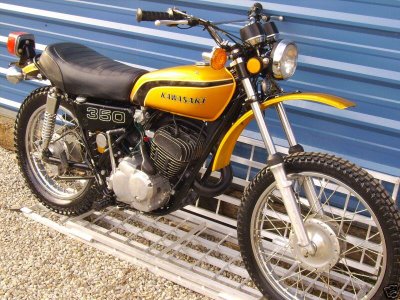
This was a real off-road vehicle. No more breaking things just because I jumped over something. I rode this thing all over south-west Virginia, usually on dirt roads, or old trails. We discovered a MotoCross track near the trailer park where John and I lived, and we would spend afternoons and weekends practicing going fast, and jumping over stuff for hours. We both became pretty good at it. I could go around corners with the bike sliding sideways, under power and going faster as we did it. Wow, we had a blast!
My problem with all of this MotoCross riding was not liking doing all of that with a dozen other motorcycles right next to me. That is what MotoCross is all about! So I decided to try riding Enduros, a solo event where you have to ride cross country, rarely on paved roads. You ride up mountains, across streams or rivers, whatever, and do it on a schedule that worked out to 24 mph. If the bike breaks, you have to fix it on the trail, then make up the lost time! Get ahead of schedule you lose points, get behind, you lose points. The rider who gets to the finish line, 100 miles away from the start,with the fewest points wins the event. For quite a while, just getting to the finish line was challenge enough! I got better at it over time.
Eventually, my friend from my high school days, Jim Coffin, who raced sports cars, noticed I was having just as much fun as he was at 1/10 the cost, so he got a bike and together we went off to a number of National Enduros all over the country. We went to the races in Southern Virginia, Delaware, Illinois, Ohio, wherever we thought there would be a good ride. And we both finished these things, but we won no trophies. Each event was a challenge, and we pushed ourselves to do this better and better each time we rode an event. We rode in almost 19 National Enduros over the course of a few years. We were having a ball learning how to ride off-road over all kinds of obstacles. (If you have read any of my other blogs (see AMA Nationals), you might know that Jim only has one eye, and the fact that he could do this is what told me I would survive the recent loss of one of my eyes!)
We even took our bikes to California one summer, and spent several weeks riding in the mountains and desert out there, it was a vacation of a lifetime. We rode in one desert race with almost 700 riders all lined up aiming at a bonfire five miles out in the desert, then it turned into an 80 mile race across trails. When the flag dropped, all those bikes (except two: Jim's and mine) took off in a huge cloud of dust. We sat there until the dust settled a bit, then we took off. By the time we hit the five mile marker, we passed over 300 bikes that had crashed into each other in that dust cloud. The leaders were miles ahead of us. But, by the time we finished, we were both in the top 50 or so. Pretty good for novices at desert racing!
Giving up Racing
After I had managed to finish those 19 Enduros on my Kawasaki, I had to give it all up. I graduated from school (a second time) and went into the Air Force with a real job.
Just before that. John and I went to Johnson City, Tennessee, and picked up several new motorcycles for his new business. Mine was a Moto Guzzi Ambassador (800cc, see, I am still on track)
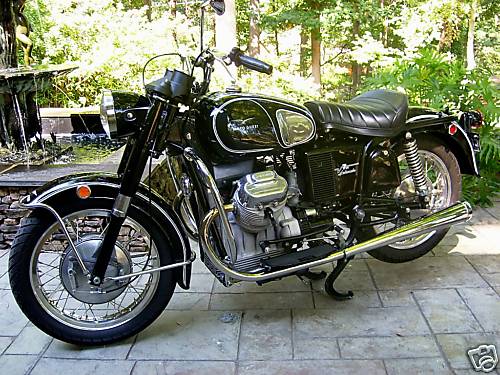
This was a "cruiser". It was smooth as silk at 80-90 mph (fast enough?) I rode it for several years, and eventually moved on to my next learning adventure: Flying!
Reviewing Edge Pushing
Before I go there, let's review. By the time I stopped actively riding, I had pushed myself to learn new skills on a motorcycle, over a long period of time. I could read the trail or road, see a problem, and knew how to avoid the problem. I could do this without even thinking. I rode a motorcycle knowing that some idiot could kill me if I let him/her get close. So, I always had my eyes peeled for the idiots, and never had any close calls.
That does not mean I never fell off!
There is an old saying in racing:
If you do not crash once in a while, you are not going fast enough.
This is really pushing the edge. You need to get to the point where you can recognize that going further just will not work, until you learn more, or get a better vehicle. If you have never failed at anything, how do you know your own limits.
I tell my students to try new things, experiment with new tools, and programming languages. Learn where their edge is, and push on it to move it further along. Maybe I could never have ridden my motorcycle at 80 miles an hour up a ramp and over a wire fence when I got that first Honda, but I sure could when I finally stopped!
Was that fast enough? Apparently not. John bought a Factory Road Racing version of the Moto Guzzi that looked something like this:

This thing had a license plate, a tiny headlight and tail light, and it was legal to drive on the highways. The fact that the top speed was over 160 mph meant it was too cool not to ride. I could not afford it, but I did take this thing out one afternoon and got it up to 145 mph before I chickened out! That dashed line in the middle of the road was solid white, and the wind was blowing over my glasses so fast I could hardly see. I came up on a left turn off the highway and decided to see how well this beast stopped, and I was going to make the left turn. So I hit the brakes when I thought I could stop, and durned near launched myself over the handle bars. That thing could go fast, and it stopped even faster. That is what it takes to be competitive in road racing, something else I did for a while back then!
On to Flying
I tell people you are immortal until you are 35, then it occurs to you that you could get killed doing the things you do. That was me on motorcycles. I decided that when I got into the Air Force, and was earning enough money to do it, I would learn to fly!
Once again, I started off slow. I took lessons at the Aero Club on Wright-Patterson AFB, near Dayton Ohio. In fact, I learned to fly on the exact same field the Wight Brothers used for their flying while they were in Dayton, Huffman Prairie. My first airplane was a simple "Honda 90". Wait, that was before, this was a Cessna 150, a nice little bird with tail number N16188. I still have my old log book where I recorded information about each flight.
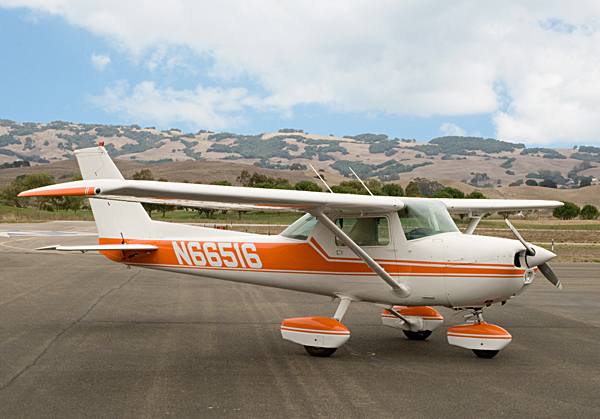
My bird was yellow, but this what she looked like! (Why are all airplanes female? Ask all the male pilots!)
This was way cool! Flying around Dayton in a high-wing airplane made for great sight-seeing, but I was trying to learn how to control this thing, and it was WAY different from driving, or riding a motorcycle. This beast could end up upside down if you were not careful, and if the engine quit, you could not drift off the road and call AAA, you had to figure out how not to kill yourself and land it in some farmer's field!
Eventually I had a life changing moment. I have written about this before (see Solo). That first time, when the instructor steps out of the plane and tells you "go around the pattern (pilot talk for taking off, going in a big oval track around the airport, and landing back where you started), and if you do not kill yourself, I will wave you on and you do it a few more times!" GULP! Way too soon, I was alone, 2000 feet in the air, in control of an airplane by myself for the very first time, and so busy I did not have time to be scared. I remember every second of that first flight, and the three more trips around the pattern I made that day!
I graduated to a bigger plane, a Cessna 172, that could carry four people.
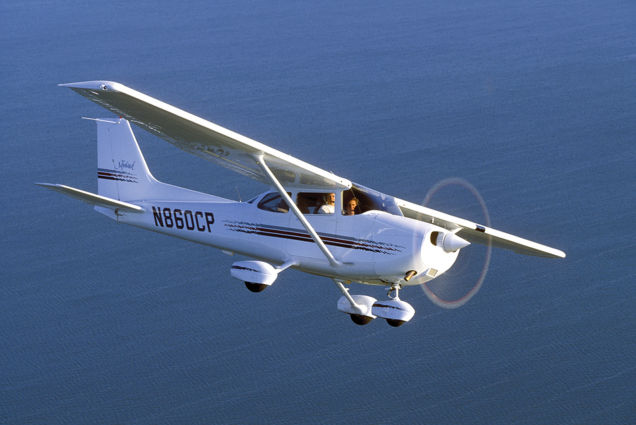
I could take a few friends on trips after I finally got my Private Pilot's license. In flying this bird, I learned how to navigate cross-country, and began my Commercial Pilot's License training. I had to get better at this if I was every going to get a job that involved flying. I was not really interested in that, but learning more was me, pushing the edge again!
I moved up to this bird, one with retractable landing gear. More stuff to learn to control:
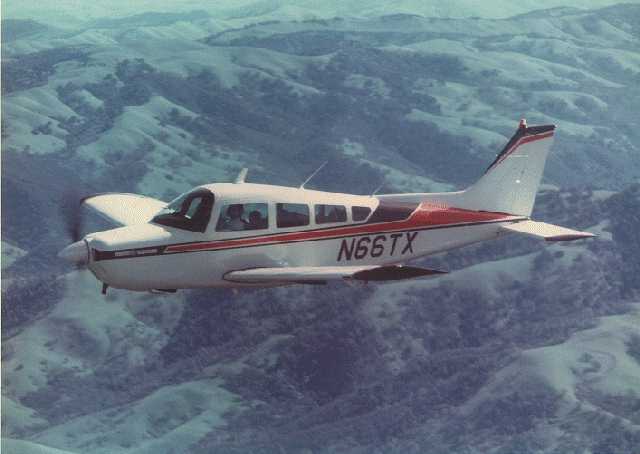
I even took on of these birds from Dayton, Ohio to New Orleans and ended up spending four days there while a thunderstorm sat over the town. So sad, I had to hang out on Bourbon Street learning how it got its name!
Pushing Yet Another Edge
After the check ride with the examiner who issued my Commercial Pilot's License, I told him this was great, but I did not know enough. He said of course, you need to learn how to fly multi-engine aircraft. That is something I never did. What I was talking about, and I told him this, was that I still felt that I did not know enough about flying to really feel like I was in control of the airplane. All of the training had been flying with the airplane right-side up. What about that other side, when the airplane is upside down. Could I handle that?
One Saturday afternoon, sitting with some friends in an observation area at the end of the runway at WPAFB, we saw a little Cessna 150 that belonged to the club approach for landing. When it was about 200 feet above the ground, it suddenly spun upside down. We were shocked, and we were sure we were about to witness an airplane crash. Instead, the airplane completed the roll, and landed safely. I later learned that a skilled Air Force pilot was training a student on that flight. When they hit something called the "wake turbulence" left in the sky from the very heavy C-141 transport plane that landed right in front of them. The little bird was thrown upside down by what amounts to a horizontal tornado. Had that student (or me) been alone at that moment, there would be no blog articles!
So, right after that, I pushed that edge again, and signed up for my first aerobatics course in one of these:
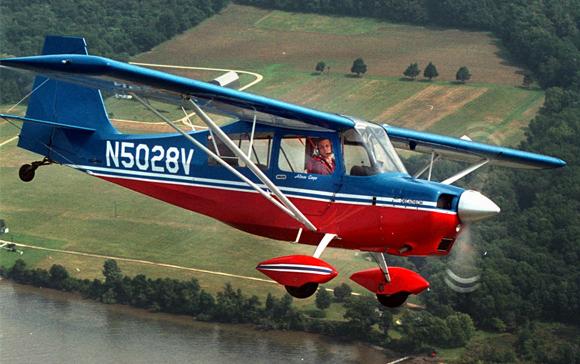
You not get into this ship, you strap it on and hook up a 5-point harness that locks you into the craft and the parachute you wear "just in case"! Wait! What was that? Yep, you actually might break this thing doing aerobatics. They do not call it "tearing holes in the sky" for nothing.
My instructor, who flew a bi-plane in air shows at King's Island Amusement Park near Cincinnati, was also a wing walker. After a half hour briefing on all the ways we could exit this bird if something broke (let me see if I remember. If the right wing breaks, go out the left side, or the front. If the left wing breaks, well, you get the idea.) I asked him if it was rational for we to fly with someone who climbed out of the door or an airplane and walked around on the wings while it was flying 100 mph a couple of thousand feet in the air! His reply was classic: "I haven't fallen off yet!". (It was the "yet" part that got to me.) Anyway, he taught me how to cruise in an airplane flying upside down. Wow, who painted Ohio on the ceiling? I was amazed that I could keep my feet on the rudder pedals while hanging from my 5-point harness. Remember that pen in your pocket. It is on the ceiling now (must remember to put it in my pants pocket next time!).
Now, I knew the basics of how to fly like this, I had flown radio controlled model airplanes for years doing just that. So when he asked me to roll the airplane 360 degrees to the left, I knew we were going to rotate the ship along the horizontal axis, be upside down for a bit, then continue on until we were right-side up again. Simple. I gulped, remembered that if I screwed this up, he could save my but, and did what he asked. And it worked! Wow!
Later he told me that most of his students chickened out when the wings got vertical, and they never completed the roll.
Next he said "let's do a loop". "Anything I should know about this?" I asked. "Sure", he replied. "Pick up some speed, say 140 mph, then pull the stick straight back and hold it". I pushed the nose down and let the airspeed go up, them pulled back on the stick which cause the plane to up and over in a complete loop. I was a little sloppy, but it worked. Hey, this is fun.
The next one was a biggie! "Let's do a hammerhead stall!" Yeah, right! I know what that one is. You pull the airplane up as though you are going to do a loop. When it is going straight up, you keep going in that direction as the speed bleeds off. Just before you stop going up, your push hard on one of the rudder pedals, and the airplane rotates around the wing-tip, and you end up going straight down. Eventually you pull out of the dive and you are back, straight, and level! Simple.
Well, I did as I was told. He told me to watch out the side window and keep the wing perpendicular with the horizon. That would mean I was climbing straight up. I felt the ship slow down, pushed the pedal, and glanced forward to make sure I was going straight down, then watched the wing again to keep it straight.
The instructor tapped me on the shoulder and said "loop out the front window". Wow, who painted Ohio all over that thing, and why is Ohio getting bigger? "You might think about pulling out". Oh yeah. I guess he is right. We do not want to become a splat on the Ohio landscape.
After the entire flight was over, I learned a valuable lesson. Adrenalin is interesting stuff. I was so wrapped up in the flight, pulling all of those G's (forces tht make you feel REALLY heavy) that I did not notice how violently we were moving around. I was fine until I walked away from the airplane, and I almost threw up. That was the adrenalin letting go. Phew. The instructor paid me an outstanding complement as well. I was the first student he had had, and he had trained quite a few, who did all the maneuvers completely on the first try. Shoot, I knew what I was supposed to do, I had studied this for years. I never got to try it out before. I was thrilled to hear that I was a pretty good pilot after all!
Well, this note is getting a bit long, so I will wrap it up here.
The Moral of the Story
Wait, there is a moral? Would I waste your time telling silly stories if I did not have a point to make? Heck no!
The moral is simple. You will never learn how to do anything if you do not try new things. You cannot become good at anything without practice. So, pick some skill you want to learn, and take a step. The edge will keep that step small. But once you have made it, push on the edge. Push yourself to learn more about this new thing. As you learn more and more, you will push harder and harder, exploring the new skills to their fullest. I believe this is the way we should live our lives. If you are really satisfied doing very little, and never trying those things you always told yourself you would do "someday", you will reach the end of your life having missed out on great adventures. I know, there is not one thing I have done in "pushing the Edge" in my life that I regret. I would do them all over again in a minute!
So, turn off that TV, put down that smart phone, get your but off of the couch, and learn something new. And, do not put off those things you always wanted to do. (Hey Collings Foundation! Where is my F4? I want my ride! Phantom Memories)
Do that every single day, and you will live a full life! And if cancer ever strikes you, you will not regret the things you never did, or never learned.
When you have your own adventures under your belt, tell your stories in a blog to inspire other folks.
That is now, and has always been my plan! I think I am on track!
Over and out!
Comments
There are no comments yet.